Facilities: Difference between revisions
m (→CSU-CHILL: Updated picture of the antenna) |
m (→CSU-CHILL: Fixed a typo) |
||
| Line 17: | Line 17: | ||
===Technical Documentation=== | ===Technical Documentation=== | ||
Technical details of the CHILL radar | Technical details of the CHILL radar are described in the {{pdf|brochure_web.pdf|CSU-CHILL Technical Brochure}}. A more detailed description of the hardware and software architecture of CHILL is given in the [[hardware description]]. | ||
==CSU-Pawnee== | ==CSU-Pawnee== | ||
Revision as of 10:19, 16 August 2009
The CSU-CHILL Site primarily hosts the CSU-CHILL S-band weather radar, along with other guest instruments. CSU also operates another S-band weather radar at the Pawnee site.
CSU-CHILL
CSU-CHILL is a transportable dual-polarization radar system, with a 9 meter parabolic reflector antenna. The radar features dual Klystron transmitters driving each polarization channel, each developing approximately 1 MW of power. The transmitters are controlled by a flexible digital waveform generator, which can synthesize a wide variety of polarization states. The low-noise receivers are attached to a customized signal processing system, which can output various polarimetric moments. Moment data, as well as raw time series data can be archived for later study. The facility is connected to the CSU network through a high bandwidth microwave link, which provides up to 30 MBps data rate.
The radar site is located near Greeley, CO at latitude 40° 26' 46.5'' (N40.44625) and longitude 104° 38' 13.5'' (W104.63708), at an elevation of 1432 meters MSL.
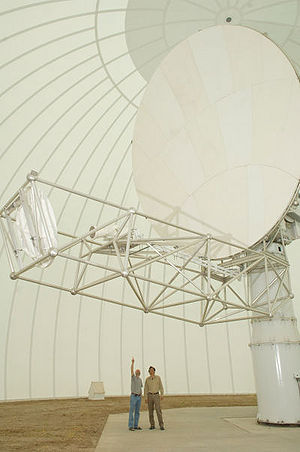
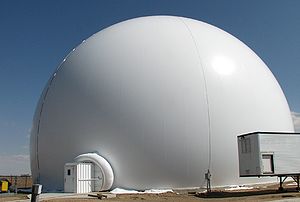
The antenna is housed within an inflatable radome, for protection against wind loading and corrsion. The radome is constructed from low-loss microwave-transparent materials. The main radar hardware is housed within the radar trailer, which contains the transmitters, receivers and control subsystems. The digitized signals from the receiver are passed through fiber-optic cables to the operations trailer, which contains the Parallel Receiver signal processor and display workstations.
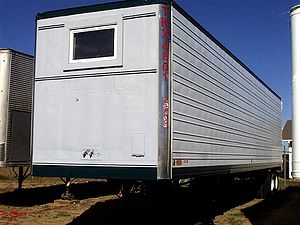
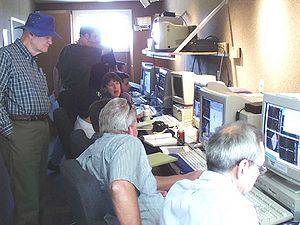
Technical Documentation
Technical details of the CHILL radar are described in the ![]() CSU-CHILL Technical Brochure
CSU-CHILL Technical Brochure  . A more detailed description of the hardware and software architecture of CHILL is given in the hardware description.
. A more detailed description of the hardware and software architecture of CHILL is given in the hardware description.
CSU-Pawnee
The CSU-Pawnee Doppler radar is a single-polarization radar sysem, with a Klystron transmitter. It is located 48 km NNW of the CSU-CHILL radar. The radar system is used in a dual-doppler configuration along with CSU-CHILL, and can perform synchronized scans.
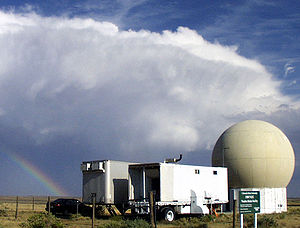
The radar transmitter frequency is 2.730 GHz, and uses a vertically polarized antenna with a 1.6° beamwidth. The signal processor used is the CHILL Parallel Receiver. The transmitter can generate an output power of 425 kW. The radar is located at latitude 40° 52.269' (N 40.87115) and longitude 104° 42.84' (W 104.714) , at an altitude of 1688 m MSL.
Some example cases of dual-doppler data collected with the CHILL-Pawnee dual-doppler network are presented in the Featured Analysis page.
2D Video Disdrometer
Main article: 2DVD
Guest Instrumentation
The CSU-CHILL site is also host to guest instrumentation from other organizations.
NCAR Weather Station
Network Connectivity
The CSU-CHILL site provides high-bandwidth network connectivity (25 Mbit) through a wireless link. The link terminates at the University of Northern Colorado, which provides high-bandwidth connectivity via fiber to the CSU main campus.
The CSU-Pawnee site uses an DSL line (512 kbit) provided by the Nunn Telephone Company.
Lab Facilities
In addition to the radar and remote sensing equipment, the CSU-CHILL facility also hosts an RF Instrument Lab, which is used by both CHILL staff as well as CSU students during construction and maintenance of the radar equipment.